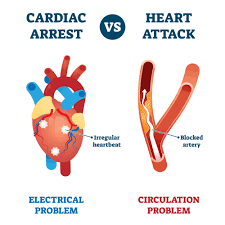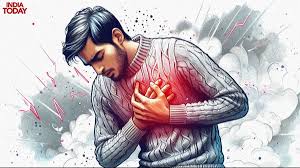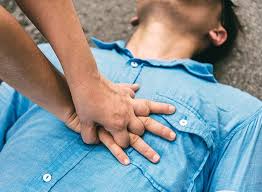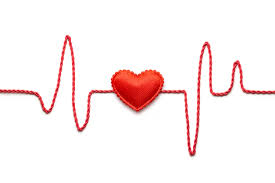Sudden Cardiac Arrest Awareness and Prevention is a critical subject which cannot be ignored. Cardiac arrest happens suddenly and without warning. The heart stops beating, cutting off blood flow to the brain and other vital organs. It’s a serious medical emergency because, without quick treatment, it can become deadly within minutes. Each year, countless lives are lost unexpectedly due to a critical condition known as cardiac arrest. In contrast to a typical heart attack, this medical emergency occurs without warning and requires immediate acion. In today’s world, where health awareness is gradually increasing, one topic that truly deserves our attention to cardiac arrest. Indeed, this life-threatening condition, if not addressed promptly, often leads to death within minutes. Therefore, understanding its causes, symptoms, and prevention strategies becomes a life-saving mission.

Cardiac arrest is a condition where the heart stops beating due to an electrical disturbance. As a result, this disruption prevents the heart from pumping blood to the brain and other vital organs. Without a doubt, without immediate medical intervention, death can occur within seconds or minutes. Unlike a heart attack, which is caused by blocked arteries, cardiac arrest is primarily an electrical issue. Nevertheless, despite their differences, both conditions may be interlinked, thereby making cardiac arrest awareness and prevention a crucial aspect of overall cardiovascular education.
A Tragic Pattern: Shefali Jariwala Dies of Cardiac Arrest at 42 and Sidharth Shukla’s Sudden Heart Attack at 40:

Shefali Jariwala, famed as the “Kaanta Laga girl” and a Bigg Boss contestant, passed away suddenly recently on June 27, 2025 in Mumbai at the age of 42 from cardiac arrest. Despite being rushed to Hospital, she was declared dead upon arrival.
Similarly, Sidharth Shukla, the beloved Bigg Boss 13 winner and television actor, died at age 40 on September 2, 2021, from a massive heart attack.

Warning Signs Risk Factors:

Sometimes, patients may experience dizziness, chest pain, shortness of breath, or heart palpitations before an attack. Common symptoms include:
- Sudden collapse
- No pulse
- No breathing
- Loss of consciousness
Hence, spreading information about these symptoms plays a vital role in cardiac arrest. Recognizing these early indicators can be the difference between life and death. While anyone can suffer from cardiac arrest, certain individuals are at greater risk. The most common cause is an arrhythmia, particularly ventricular fibrillation. Other contributing factors include:
- Coronary artery disease
- Heart failure
- Congenital heart conditions
- Drug abuse
- Intense physical activity in people with undiagnosed heart issues
Early Diagnosis is Important:
Timely diagnosis is essential in preventing cardiac arrest like regular cardiac evaluations, including ECGs, stress tests, and echocardiograms, can help detect irregular heart rhythms or structural abnormalities. In fact, one of the core pillars of cardiac arrest is encouraging individuals, especially those with a family history of heart disease, should go undergo routine heart health checkups.
Moreover, wearable health technology like smartwatches with ECG functionality can help monitor heart rhythms and alert users to potential dangers. Undoubtedly, these innovations are valuable tools in the ongoing battle for cardiac arrest.
Every Second Counts: Responding to Sudden Cardiac Arrest:
When sudden cardiac arrest strikes, every second truly counts. In such situations, an immediate response can dramatically improve the chances of survival. To respond effectively, it’s important to follow these three crucial steps:
- First, call emergency services without delay.
- Next, begin CPR—chest compressions help keep blood circulating to vital organs.
- Finally, use an AED, if one is available, this life-saving device can help restart the heart.
Fortunately, public access to AEDs is available in places like malls, airports, gyms, and schools has become a game-changer in emergency care. However, without the proper training or awareness, bystanders might hesitate or fail to act at all. Therefore, increasing of sudden cardiac arrest widespread CPR and AED training is essential. By doing so, we can empower individuals and communities to respond with confidence and potentially save lives during these critical moments.
Why CPR Training Matters:

Cardiopulmonary resuscitation (CPR) is, without a doubt, the cornerstone of emergency response for SCA. Unfortunately, many people still don’t know how to perform it. As a result, community CPR training programs should be actively encouraged and even made mandatory in schools and workplaces. Moreover, governments and NGOs must come together to make awareness and prevention a national priority by funding training drives and awareness campaigns. In fact, many organizations are already providing CPR training to their employees as part of their health and safety initiatives. Therefore, education remains a pivotal tool in achieving wider cardiac arrest awareness and prevention.
Healthy Living and Diet Choices:

Maintaining a healthy lifestyle plays a substantial role in preventing cardiac issues. To begin with, a diet low in saturated fats and sugars, combined with regular physical activity, significantly reduces the risk of heart disease. In addition, smoking and limiting alcohol consumption are also crucial.
Furthermore, incorporating practices, such as yoga and meditation, can effectively reduce stress—another key contributor to heart problems. Therefore, promoting healthy living is indirectly but significantly tied to sudden cardiac arrest.
Government Responsibility and Community Engagement:
Governments have a major role to play in implementing broader health initiatives. For example, schools, universities, and corporate offices should be equipped with AEDs and conduct regular first-aid workshops. In addition, health policies should support routine cardiac checkups and ensure access to affordable heart care facilities.
Equally important, public health campaigns for cancer or diabetes are essential for sudden cardiac arrest. By leveraging advertisements, social media, and community outreach, governments can foster a well-informed population that clearly understands the importance of early action and prevention.
Communities thrive, especially when people support one another. To that end, establishing local cardiac health clubs, peer-to-peer education programs, and neighborhood emergency response teams can significantly deepen sudden cardiac arrest awareness and prevention. Moreover, these grassroots efforts build resilience and readiness, ensuring that help is never too far away.
In the same way, faith-based groups, cultural organizations, and schools can be powerful allies in spreading awareness. By actively engaging all segments of society, we ensure a holistic and inclusive approach to combating sudden cardiac arrest.
The Digital Shift in Heart Health Monitoring:
Technology continues to revolutionize healthcare, transforming the way we prevent and respond to medical emergencies. For instance, portable AEDs, smartwatches, and AI-powered health monitoring systems are making it easier to detect and prevent cardiac events. Additionally, mobile apps now provide CPR instructions and guide users to the nearest AED location. Undoubtedly, these advancements are instrumental in advancing sudden cardiac arrest awareness and prevention.
Looking ahead, machine learning algorithms could potentially predict cardiac events based on data trends. Therefore, embracing these technologies and educating the public about their use can dramatically improve outcomes.
Prevention Starts with Awareness and Action:
Therefore, sudden cardiac arrest awareness and prevention are more than just a health initiative. It is a powerful movement that has the potential to save millions of lives. As discussed throughout, understanding the causes, recognizing the symptoms, promoting CPR training, and encouraging healthy lifestyles are all essential components of prevention. Moreover, leveraging technology, strengthening community involvement, and ensuring institutional support further magnify the impact of these efforts.

With that in mind, let us pledge to make cardiac arrest a widely effectively addressed condition. After all, awareness is the first step toward prevention, and prevention remains the most powerful tool we have to protect our hearts and those of our loved ones.
